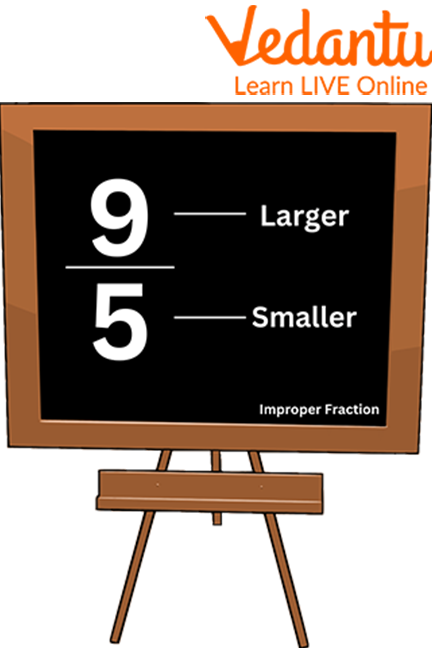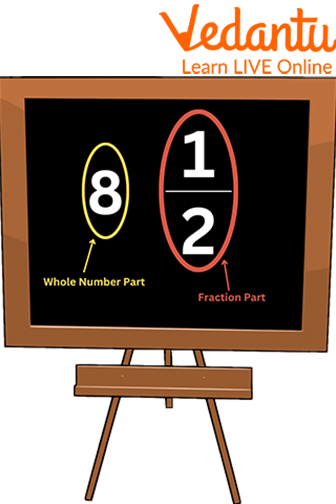




Key Steps and Tricks for Turning Fractions into Whole Numbers
Fractions represent any number of equal parts in a whole number. It is shown in the form of '/', as in, a/b. The number on the top is known as the ‘numerator’, and the number below is known as the ‘denominator’. Derived from the original Latin word 'Fractus,' the term ‘fraction’ means broken.
In the section on converting fractions, we'll go through how to convert improper fractions to whole or mixed numbers, improper fractions to mixed numbers, and whole numbers to improper fractions. Let’s get started on learning about it.
Whole Numbers
Natural numbers along with zero (0) are referred to as whole numbers. We know that natural numbers refer to a set of counting numbers starting from 1, 2, 3, 4, and so on. Whole numbers are part of real numbers including all the positive integers and zero, but not fractions, decimals, or negative numbers.
The set of whole numbers in Mathematics is given as {0, 1, 2, 3, ...} which is denoted by the symbol W.
W = {0, 1, 2, 3, 4, …}
Understanding Fraction Number
In Mathematics, fractions are represented as a numerical value, which defines a part of a whole. A fraction can be a portion or section of any quantity out of a whole, where the whole can be any number, a specific value, or a thing.
Improper Fraction
An improper fraction is the type of fraction in which the numerator is more than or equal to its denominator. It is always the same or greater than the whole. For Example: $\dfrac{9}{5}$, $\dfrac{7}{3}$, $\dfrac{5}{2}$...etc.

Improper Fraction
Mixed Fraction
A mixed number, like $1 \dfrac{1}{3}$, is one that combines a whole number and a fraction. In this instance, the word "remainder" is used to describe the fraction $\dfrac{1}{3}$. A full number, on the other hand, is a number like 2, 3, and $4 .$

Mixed Fraction
How to Convert a Fraction Into a Whole Number
To convert a fraction into a whole number:
Divide the numerator by the denominator, only if the numerator is a multiple of the denominator.
Example: Convert $\dfrac{4}{2}$ into a whole number.
Ans: Here the numerator is 4 and the denominator is 2.
Since we know that to make this fraction into a whole number, the numerator should be a multiple of the denominator.
Here, 4 is the multiple of 2.
Therefore, we can write $\dfrac{4}{2}=2$
Hence, $\dfrac{4}{2}$ into a whole number is equal to 2.
Converting Improper Fractions Into Whole Numbers
The following are the steps to convert improper fractions into whole numbers:
Step 1: Verify if the fraction's numerator is bigger than or equal to the denominator by looking at the fraction's numerator.
For Example, $\dfrac{24}{12}$, where the numerator is 24 and the denominator is 12. So, the numerator is greater than the denominator.
Step 2: Now, we can change our improper fraction into a whole number if the above condition follows.
If the numerator is larger than the denominator, divide it and check the remainder. As there should not be any remainder left.
For instance, if the improper fraction is $\dfrac{24}{12}$ perfectly divided by 12, leaving no remainder, and gives the result as 2.
Note: The fraction cannot be converted into a whole number if there is a remainder when the numerator and denominator are divided.
Solved Examples
Q1. Convert the whole number “10” into a fraction.
Ans: Given that the whole number is 10
Multiply and divide the number by 1
$n=10 \times \dfrac{1}{1}$
$n=\dfrac{10}{1}$
Hence, the fraction is $\dfrac{10}{1}$
Q2. Convert $\dfrac{27}{18}$ into a mixed number.
Ans: Divide the numerator by the denominator:
$27 \div 18=1$ with the remainder of 9.
Now, write down the whole number 1 and then write down the rem numerator (9) above the denominator (18) as:
$1 \dfrac{9}{18}$
You can reduce the fraction part of this mixed number :
Find the greatest common factor of 9 and 18
$\operatorname{GCF}(9,18)=9$
$\dfrac{9 \div 9}{18 \div 18}=\dfrac{1}{2}$
Therefore, the improper fraction $\dfrac{27}{18}$ converted to a mixed number is: $1 \dfrac{1}{2}$.
Q3. Simplify improper fractions $\dfrac{8}{6}+\dfrac{10}{6}$ and find out whether the result is a whole number or not.
Ans: $\dfrac{8}{6}+\dfrac{10}{6}$
Here the same denominator is $6 .$
$=\dfrac{8}{6}+\dfrac{10}{6}$
$=\dfrac{(8+10)}{6}$
$=\dfrac{18}{6}$
Here $\dfrac{18}{6}$ is an improper fraction after further simplifying,
$=\dfrac{18}{6}=3$
Practice Questions
Q1. Change the whole number 6 into an improper fraction.
Ans: $\dfrac{36}{6}$
Q2. Change $\dfrac{16}{8}$ into a whole number.
Ans: $2 .$
Q3. Convert $\dfrac{34}{8}$ into a mixed number.
Ans: $4 \dfrac{1}{4}$
Summary
We turn the fraction into an operational version of the mathematical expression in order to deal with expressions such as those that are improper. However, the majority of improper fractions are transformed into mixed numbers with a remainder. Some improper fractions can be transformed into whole numbers. A fraction can only be expressed as a whole number when the numerator is a multiple of the denominator. If there is a remainder after dividing the numerator and denominator, the fraction cannot be expanded into a whole number.
FAQs on How to Convert a Fraction Into a Whole Number: Explained
1. How do I turn a fraction into a whole number?
To convert a fraction into a whole number, check if the numerator is a multiple of the denominator. If it is, divide the numerator by the denominator. For example, $\frac{8}{4} = 2$. Fractions that are not multiples do not become whole numbers.
2. What is 3/5 as a whole number?
The fraction 3/5 cannot be directly converted into a whole number because 3 is not a multiple of 5. When you divide 3 by 5, you get 0.6, which is a decimal, not a whole number.
3. How to change 3/4 into a whole number?
You cannot change 3/4 to a whole number directly since 3 divided by 4 equals 0.75. A fraction to whole number conversion is only possible if the numerator is divisible by the denominator without a remainder.
4. What is 0.333333333333333 as a fraction?
The decimal 0.333333333333333 can be written as the fraction $\frac{1}{3}$. This is because the repeating 3s indicate it is a recurring decimal, which exactly equals one-third when expressed as a fraction.
5. What is a whole number in terms of fractions?
A whole number is any non-negative integer. In fractions, a whole number can be written as
- the numerator is a multiple of the denominator, like $\frac{8}{4} = 2$
- or as fractions like $\frac{5}{1} = 5$
6. Can all fractions be converted to whole numbers?
Not all fractions can be converted into whole numbers. Only when the numerator is a multiple of the denominator, the division results in a whole number. Otherwise, the result is a decimal or mixed number, not a whole.
7. What is the formula to check if a fraction is a whole number?
To determine if a fraction is a whole number, use the formula: $n \div d$. If $n$ (numerator) divided by $d$ (denominator) has no remainder, the result is a whole number. Example: $\frac{6}{2} = 3$.
8. How can I convert an improper fraction to a whole number?
To convert an improper fraction to a whole number, divide the numerator by the denominator. If the result has no remainder, the answer is a whole number. For example, $\frac{12}{4} = 3$, which is a whole number.
9. Why can't 3/5 and 3/4 be made into whole numbers?
Fractions like 3/5 and 3/4 cannot become whole numbers because 3 divided by 5 or 4 gives decimals, not integers. Only fractions where numerator is a multiple of denominator turn into whole numbers.
10. Can you round a fraction to the nearest whole number?
Yes, you can round a fraction to the nearest whole number. Divide the numerator by the denominator, then round the resulting decimal to the closest integer. For example, $\frac{7}{4} = 1.75$, rounded to 2.
11. What is the process to convert a decimal into a fraction first, then a whole number?
First, write the decimal as a fraction (e.g., 0.5 is $\frac{1}{2}$). Then check if this fraction equals a whole number. If not, see if it can be simplified or rounded to a whole number if needed.

















